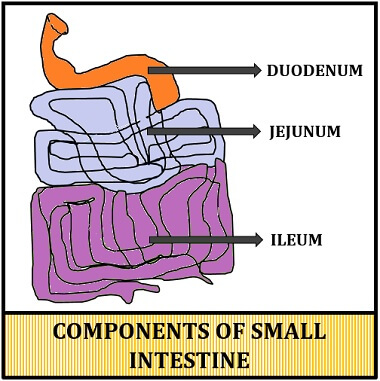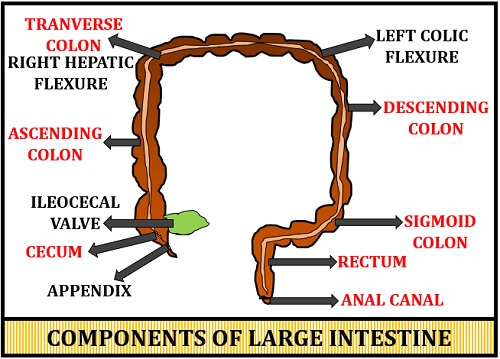The difference between the small intestine and large intestine is mainly due to the three factors like length, diameter and involvement in the digestion. Both small and large intestine belongs to the intestinal system.
Length: The small intestine’s length is 9 m that is larger than the large intestine whose length is about 1.5 m.
Diameter: The small intestine diameter or width is 3.5-4.5 cm smaller than the large intestine whose diameter is about 4-6 cm.
Involvement in the digestion: The small intestine participates in the digestion process, whereas large intestine does not participate in the digestion.
Content: Small Intestine Vs Large Intestine
Comparison Chart
| Properties | Small intestine | Large intestine |
|---|---|---|
| Definition | It is the intestinal part which extends from the stomach to the large intestine | It is the terminal intestinal part which extends from the appendix to the anus |
| Length | 9 meters in length | 1.5 meters in length |
| Width | 3.5 - 4.5 cm in diameter | 4-6 cm in diameter |
| Components | Duodenum, jejunum and ileum | Colon, cecum, rectum and anal canal |
| Movement | Exhibits small movement | There is no movement as the large intestine is fixed |
| Villi | Present in the internal surface | Absent |
| Peyers Patches | Present in the internal surface as aggregation of lymphoid tissue | Absent |
| Haustra | Absent | Present |
| Epiploic appendages | Absent | Present |
| Circular folds | Palicae circulares present | Absent |
| Muscle bands | Consist of circular layer of longitudinal muscle | Consist of longitudinal muscles in three bands known as Tineae coli |
| Wall surface | Smooth | Sacculated |
| Absorption | Involved in absorption of nutrients from the digested food | Involved in absorption of water and electrolytes from the undigested portion of food |
| Function | Helps in digestion of the undigested or partially digested food by secreting intestinal fluids | It expels out the waste material through the anus |
Definition of Small Intestine
The small intestine extends from a lower part of the stomach to a large intestine part. It is a very long and narrow tube with a smooth wall surface. It appears as a coiled tube in the abdominal region and comprises three components from the proximal end to the distal end. Duodenum, jejunum and ileum are the three sections of the small intestine. It performs several functions in the abdominal region like digestion of food, absorption of nutrients etc.
Definition of Large Intestine
The large intestine extends from the appendix to the anus. It appears as a wider and short tube with a sacculated wall surface. The large intestine frames the coiled tube (small intestine) in the abdominal region and comprises four components. Cecum, colon, rectum and anal canal are the four sections of the large intestine. It conducts several functions in the abdominal region like the movement of food, adsorption of electrolytes and water etc.
Parts of Small Intestine
It comprises of three components like:

- Duodenum: It is the first part of the small intestine, which is the shortest region (measures 25.4 cm). Duodenum begins from the pyloric sphincter. It bends posteriorly behind the peritoneum. Then duodenum appears as a C-shape around the pancreas. Duodenum then again bends or returns to the peritoneal cavity and joins with the jejunum cavity. The ampulla is the region that opens into the duodenum.
- Jejunum: It is the second portion of the small intestine that measures 0.9 m length. The jejunum is the part of the small intestine that begins from the duodenum’s distal end to the terminal part of the ileum. It is present in the posterior abdominal wall.
- Ileum: It is the longest part of the small intestine that measures 1.8 m length. The ileum appears thick and develops mucosal folds. It joins the cecum of the large intestine to the ileocecal valve. The ileum is located at the posterior abdominal wall.
Parts of Large Intestine
It includes four components like:

- Cecum: It is the first region of the large intestine that seems sac-like. The cecum is inferior to the ileocecal valve. It measures a length of 6 cm. A vermiform appendix comprises of lymphoid tissues, and it opens into the cecum.
- Colon: It moves upwards on the right side of the abdomen called ascending colon. Then the colon slightly bent and termed as transverse colon where it forms right colic or hepatic flexure. Colon then moves towards the abdomen’s left side and bends sharply to form left colic or splenic flexure. Then, it travels downward and termed as the descending colon. Finally, colon inferiorly enters to the pelvis and forms a sigmoid colon that extends medially.
- Rectum: Sigmoid colon opens into the rectum and reaches anteriorly to the sacrum and coccyx. Rectum possesses rectal valves that hold three lateral bends of the transverse folds. Its primary function is the separation of faeces and gas to prevent simultaneous release.
- Anal canal: It is the last part of the large intestine. The anal canal is located in the perineum region and outside the abdominal pelvic cavity. It measures 3.8-5 cm in length. Anal canal comprises of two sphincters:
- Internal anal sphincters: It is composed of smooth muscle, i.e. it is under the control of involuntary muscle activity.
- External anal sphincters: It is composed of skeletal muscle, which is under voluntary control.
Key Differences Between Small Intestine and Large Intestine
- The small intestine is the intestinal part extending from the stomach to the large intestine opening, i.e.cecum. The large intestine is the intestinal part extending from the appendix to the anal canal.
- Small intestine measures 9 m length and 3.5-4.5 cm diameter, whereas large intestine measures 1.5 m length and diameter of 4-6 cm.
- Small intestine exhibits small movement, while large intestine remains fixed.
- Villi are the finger-like projections found in the small intestine’s internal surface that expand the surface area for absorption and help in food digestion, whereas they are absent in large intestine.
- Peyer’s patches seem like small patches and comprise lymphoid tissue. Peyer’s patches are found in the small intestine in the ileum region, whereas absent in large intestine.
- Haustra are the sac-like structures found in the large intestine, while absent in the small intestine.
- Epiploic appendages appear as the small pouches along the colon, present in the large intestine and absent in the small intestine.
- Circular folds (Palicae circulares) exist in the small intestine, while absent in large intestine.
- The wall surface of the small intestine appears smooth, whereas sacculated in the large intestine.
- The small intestine absorbs nutrients, whereas the large intestine absorbs water and electrolytes from the food.
Conclusion
We can conclude that there are many differences in the size, structure, and function etc. between the small and large intestine. Despite many differences, both small and large intestine works coordinately. The intestine is the long muscular tube, which extends from the lower part of the stomach to the anus. The intestine is the part of the digestive system, which broadly consists of two sections (small and large intestine). It carries out the major functions like digestion, movement of food, and absorption of nutrients. Thus, these two completes the digestive system.